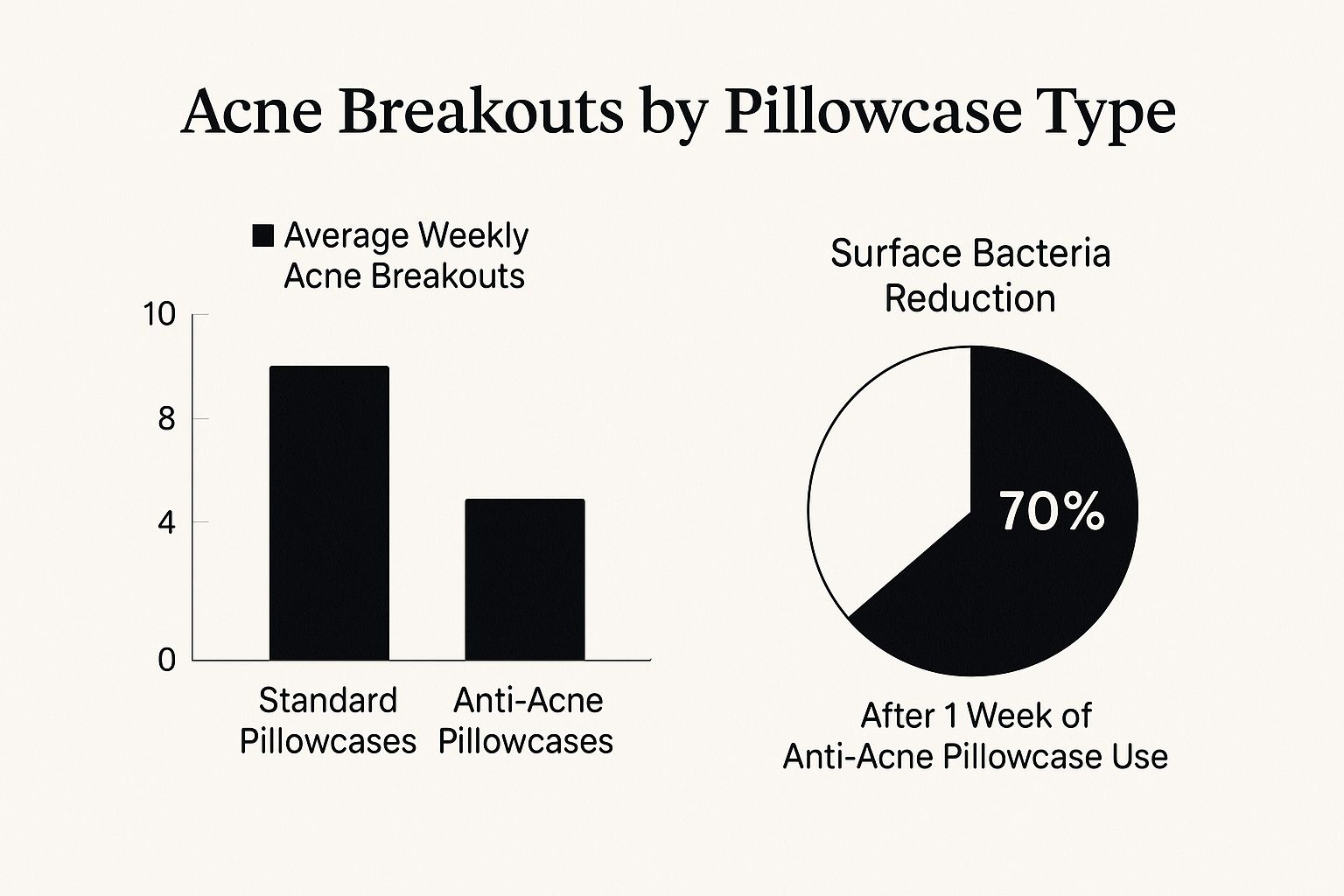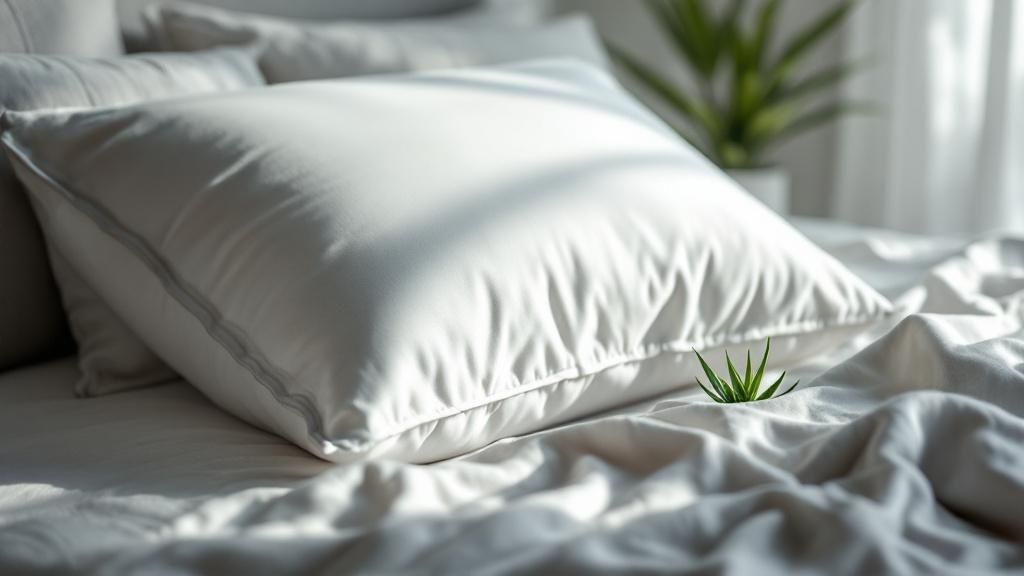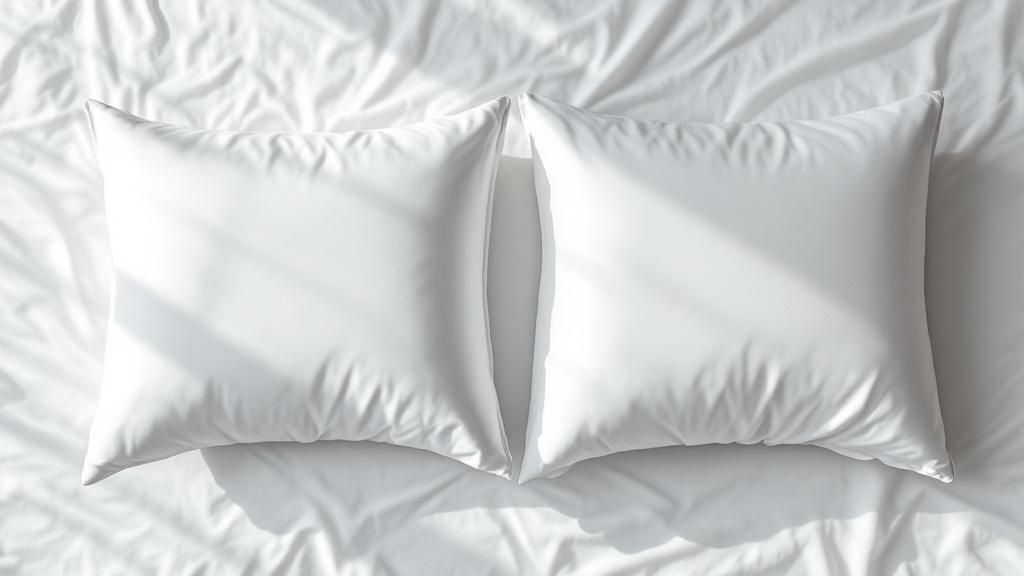So, how exactly does an anti-acne pillowcase work its magic? It all comes down to creating a much cleaner and gentler surface for your face to rest on all night. Your standard cotton pillowcase, as cozy as it feels, can actually be a bit of a secret saboteur, trapping bacteria, soaking up your expensive skincare products, and creating friction that irritates your skin.
Specialized pillowcases, on the other hand, are typically made from materials like silk, silver-infused fabrics, or bamboo. These are chosen specifically to minimize skin irritation and help prevent breakouts while you're getting your beauty sleep.
How a Pillowcase Can Genuinely Transform Your Skin
It sounds almost too simple to be true, doesn't it? But think about it: your face is pressed against that surface for roughly eight hours every single night. That's a long time, and the material it touches can either help or hinder your skin's health.
A typical cotton pillowcase can work against your best skincare efforts in three main ways: creating friction, stealing moisture, and becoming a breeding ground for bacteria. An anti-acne pillowcase is designed to tackle these problems head-on. The incredibly smooth texture means less pulling and physical stress on your skin, which is a game-changer for preventing the tiny micro-tears that can flare up into inflammation and redness.
The Science Behind a Cleaner Sleep Surface
Beyond just being smooth, these pillowcases are far less absorbent. This is a huge benefit. It means your night creams and healing serums stay on your face where they belong, instead of getting sucked into the fabric. Less absorption also means less of your skin's natural oils, sweat, and dead cells get trapped in the pillowcase, creating a much less hospitable environment for acne-causing bacteria.
The proof is in the numbers. The demand for these pillowcases is exploding, with the global beauty pillowcases market projected to reach a staggering USD 1.49 billion by 2030. A big reason for this growth is the mounting evidence, including clinical trials showing that materials like silk can lead to a significant reduction in acne compared to cotton. You can dive deeper into these trends in this market analysis from Grand View Research.
This chart gives you a clear picture of the difference it can make, comparing average weekly breakouts and bacteria levels.

As you can see, making the switch can result in noticeably fewer breakouts and a dramatic drop in surface bacteria. It’s a simple change, but it provides powerful support for a healthier skin barrier, making it a truly foundational piece of any effective acne-fighting strategy.
Pillowcase Material Comparison for Acne-Prone Skin
Choosing the right material is key, as each one offers a unique combination of benefits. Here’s a quick breakdown to help you compare the most common options.
| Material | Friction Level | Moisture Absorption | Antibacterial Properties |
|---|---|---|---|
| Silk | Very Low | Low | Natural |
| Silver-Infused Fabric | Low | Low | High (from silver ions) |
| Bamboo | Low | Moderate | Natural |
| Satin (Polyester) | Very Low | Very Low | None |
| Cotton | High | High | None |
Ultimately, materials like silk and silver-infused fabrics often come out on top for their low friction and impressive antibacterial qualities. However, bamboo and high-quality satin can also be excellent, more budget-friendly alternatives to traditional cotton.
Choosing the Right Material for Your Acne Type

When it comes to fighting breakouts, not all acne is created equal—and the pillowcase you sleep on shouldn't be either. I’ve seen clients get frustrated when a "miracle" product doesn't work, and often it’s because it wasn't right for their specific skin issue. Moving beyond a one-size-fits-all approach is where you’ll see real results.
For example, if you're constantly battling sensitive, inflamed skin that flushes red at the slightest touch, your top priority should be finding a fabric with an incredibly smooth surface. The idea is to cut down on the physical irritation that can make redness and painful flare-ups even worse.
Matching Material to Your Skin Concern
Let's break down how to connect your skin’s needs with the right fabric. First, what’s your primary struggle? Are you dealing with deep, painful inflammation from hormonal or cystic acne? Or is your battle more about managing the surface bacteria that leads to smaller pimples and clogged pores?
-
For Sensitive or Inflamed Acne: If your skin is easily aggravated, red, and prone to those stubborn cystic or hormonal breakouts, you need a material that causes the least amount of friction. Mulberry silk is a fantastic choice here. Its long, smooth fibers glide across your skin instead of dragging on it.
-
For Bacterial or Comedonal Acne: When the main problem is clogged pores (comedones) or a steady stream of pustules, a pillowcase with antimicrobial properties can be a game-changer. Fabrics infused with silver or copper ions are designed to actively stop bacteria from multiplying on the surface, which helps keep your sleep environment much cleaner.
Selecting the right pillowcase material is a personal choice. Your goal isn't just to buy a popular product, but to pick a tool that directly targets what's causing your specific acne—be it friction, bacteria, or moisture loss.
Thinking Beyond the Label
The demand for targeted skincare has exploded, and it’s no surprise the global acne treatment market is projected to reach USD 16.91 billion by 2034. While your cleansers and treatments are the stars of the show, a specialized anti-acne pillowcase plays a crucial supporting role. It works behind the scenes, tackling environmental triggers while you sleep. You can dive deeper into how lifestyle products fit into the bigger picture in this market forecast by Precedence Research.
This is where knowing your natural fibers comes in handy. Silk is incredible for reducing friction, but other materials like bamboo bring their own unique advantages to the table. Bamboo is naturally hypoallergenic and highly breathable, which is a huge plus for anyone who sleeps hot or has sensitive skin. To get the full scoop on its benefits, you can learn more about bamboo pillowcases in our detailed guide.
What to Look For When You Buy

When you're ready to buy an anti-acne pillowcase, the market can feel a bit crowded. It's easy to get lost in the marketing claims, but knowing a few key details will help you spot the products that actually deliver from the ones that are all hype. This is about making a smart investment for your skin's health.
For silk pillowcases, the most important term you'll see is momme count. Think of it like thread count for cotton—it’s a measure of the silk's weight and quality. I always recommend looking for a pillowcase with 22-momme or more. Anything less might feel nice at first, but a higher momme count means you're getting a denser, more durable fabric that offers that signature glide and will last through countless washes.
Essential Quality Certifications
You'll also want to keep an eye out for an OEKO-TEX Standard 100 certification. This isn't just a fancy label; it's a third-party guarantee that the fabric, thread, and even the zipper have been rigorously tested and are free from harmful chemicals. For anyone battling acne or sensitivity, this is your peace of mind that you're not resting your face on potential irritants all night.
Beyond the fabric itself, look at how the pillowcase is made. A zipper closure is a small detail that makes a huge difference. It fully encases your pillow, keeping it secure and preventing the pillowcase from sliding off. More importantly, it acts as a barrier, helping to keep dust mites and other allergens trapped inside the pillow and away from your skin.
My rule of thumb: A high momme count ensures quality and longevity, while an OEKO-TEX certification ensures it's safe for your skin. You really want both for an effective anti-acne pillowcase.
Material and Hygiene Considerations
Of course, the material is the star of the show. While silk is famous for its incredible smoothness, it's not the only game in town. Don't overlook materials like bamboo, for instance. Many people swear by the antibacterial benefits of bamboo sheets and pillowcases, which can be a huge plus for maintaining a cleaner sleep surface.
Finally, trust your gut. If a price seems too good to be true or the reviews are all vague and generic, it might be a red flag. A well-made anti-acne pillowcase is a specialized product. Investing a little more in one with proven features and transparent certifications is the surest way to get the clear-skin results you're after.
Getting the Most Out of Your Pillowcase
So you've invested in an anti-acne pillowcase. That's a great first step, but it’s not magic. To really see the benefits for your skin, you have to treat it right. Think of it as a key part of your skincare toolkit, one that needs a little maintenance to do its job.
Your pillowcase is designed to create a cleaner surface for your face all night long. But it still comes into contact with your skin’s natural oils, sweat, and stray skincare products. If you don't wash it regularly, that buildup can negate all the benefits you bought it for.
This is especially true for delicate materials like silk or specially treated bamboo. You can't just toss these in with your regular laundry. Stick to a gentle, pH-neutral liquid detergent, because harsh chemicals and powders can break down the very fibers that make the pillowcase so smooth and effective.
How to Care For Your Pillowcase and Maximize Its Lifespan
Keeping your pillowcase in top shape is the goal. For most of these specialty fabrics, a wash at least once a week is a good rule of thumb. If you have particularly oily skin or are in the middle of a bad breakout, you’ll want to wash it even more often—every 3-4 days is ideal.
Here are a few tips I always give people:
- Washing: The best method is to hand wash in cold water. If you absolutely must use a machine, pop the pillowcase into a mesh delicates bag and run it on the coldest, most gentle cycle your machine has.
- Drying: Whatever you do, don't wring it out! That twisting motion will destroy the delicate fibers. Instead, lay it flat on a clean towel, roll it up gently to press out the excess water, and then hang it or lay it flat to air dry. Keep it out of direct sunlight and away from high heat.
One of the best things about a quality anti-acne pillowcase is that it’s less absorbent. This means your expensive night serums and creams stay on your face where they belong, instead of getting soaked up by your bedding. Taking proper care of the fabric protects this feature, ensuring you get the full value from both your pillowcase and your skincare products.
The Future of Skincare Textiles

That anti-acne pillowcase on your bed isn't just bedding. It's a genuine preview of how our everyday fabrics are becoming an extension of our skincare routines. The smooth, antibacterial surfaces we see now are only the first step in a much bigger movement toward intelligent, active textiles.
The next wave is already here, and it's built on technologies like microencapsulation. Think about a pillowcase that's engineered to gradually release soothing ingredients while you sleep. We're talking about microscopic capsules, woven right into the fibers, that could deliver a steady dose of aloe vera, hyaluronic acid, or even gentle anti-inflammatory compounds all night long.
Smart Fabrics That Do More Than Just Protect
This is a huge leap from simply preventing breakouts to actively improving your skin's health. It’s no surprise that this market is projected to hit an estimated USD 1,751.0 million by 2034. This growth is all about fabrics that don't just fight acne triggers but also hydrate, help boost collagen, and provide targeted treatments. For a deeper dive into the numbers, check out this insightful beauty pillowcase market report.
The takeaway is simple: we're shifting from passive prevention to active treatment. Your pillowcase will become a key player in your nightly skin recovery strategy, not just a barrier against bacteria.
If we look even further down the road, the possibilities get really exciting. Imagine smart fabrics with tiny, embedded sensors. These textiles could monitor your skin’s moisture levels or inflammation in real-time, then adapt their function to give you a completely personalized treatment. It might sound like something out of a sci-fi movie, but it's the logical next evolution in creating a truly intelligent sleep environment.
By choosing an anti-acne pillowcase now, you're already participating in this exciting wellness movement.
Answering Your Top Questions About Anti-Acne Pillowcases
So, you're thinking about making the switch to an anti-acne pillowcase. It's a fantastic move for your skin, but it's totally normal to have a few questions before you commit. I've heard them all over the years, so let's walk through the most common ones.
How Long Until I Actually See Results?
This is usually the first thing people ask. While some might feel a difference in skin irritation or see less morning redness almost immediately, real changes to your acne take a bit longer.
You'll want to give it about 4 to 8 weeks to see a noticeable reduction in breakouts. Think of it as a long-term strategy—every single night, you're providing a cleaner, gentler surface for your skin, and those benefits build up over time.
How Do I Take Care of It for the Best Results?
Washing instructions are another hot topic. People often wonder if they really need a special detergent for materials like silk or bamboo. The short answer is yes.
Using a gentle, pH-neutral liquid detergent is non-negotiable. Harsh soaps and powders can actually break down the pillowcase's delicate fibers, which is the last thing you want. It strips away the very qualities you bought it for! Always double-check the care label, but gentle handling is the golden rule.
Are There Any Downsides I Should Know About?
Let's be realistic—the main things to consider are the upfront cost and the extra care they require. A truly high-quality anti acne pillowcase will be more of an investment than a standard cotton one, and you can't just toss it in the wash with your towels.
But for most people, the trade-off is well worth it. The confidence that comes with clearer skin often far outweighs the initial price and the few extra minutes spent on laundry day.
Finally, it’s important to remember that a pillowcase is just one piece of the puzzle. For a truly effective approach, you have to look at the bigger picture. Understanding how quality sleep impacts your health is a great place to start. When you combine a great pillowcase with a consistent skincare routine and healthy sleep habits, you're setting yourself up for the best possible results.
Ready for a better night's sleep and clearer skin? Discover the luxurious feel and skin-clearing benefits of Bamtek's 100% organic bamboo bedding. Shop our collection today.










